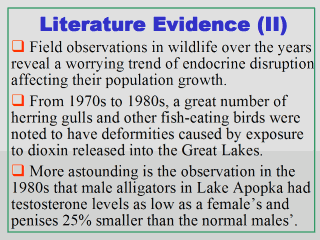| front |1 |2 |3 |4 |5 |6 |7 |8 |9 |10 |11 |12 |13 |14 |15 |16 |17 |18 |19 |20 |review |
 |
Field observations
in wildlife over the past 50 years reveal a worrying trend of adverse
effects on their population growth and reproductive health in the ecosystem.
It is believed that much of these adverse health effects are caused by
endocrine disruption of pollutants persistently available in the
environment. As a matter of fact, there is already evidence of reproductive
abnormalities seen in birds, fish, and mammals. Cross-sex masculinization
and feminization are also seen in fish, birds, turtles, and other wildlife
species. Between early 1970s and late 1980s, a great number of the herring gulls and other colonial fish-eating birds near Lake Ontario were found to have some type of edema disease and deformities. It was Gilbertson et al. (1991) who first associated the edema and deformities syndrome with dioxin, which is a well-recognized environmental endocrine disruptor. Dioxin has been released into the Great Lakes from manufacturing plants since the 1930s. Even astounding is the observation in the 1980s that male alligators in Lake Apopka, Florida had testosterone levels as low as a typical femaleís, and penises about 25% smaller than those in normal males. Subsequent studies by Guillette et al. (1994, 1996) indicated that the p,pí-DDE, a major contaminant in Lake Apopka, was likely the chemical culprit. In the quasi-field settings, tadpoles of the gray treefrog species were seen to be less capable of avoiding predators following exposure to low level of the pesticide carbaryl, (Relyea and Mills, 2001). More green frog tadpoles were also seen to reach metamorphosis after exposure to the carbaryl (up to) 3 times at various developmental stages (Boone and Bridges, 2003). |